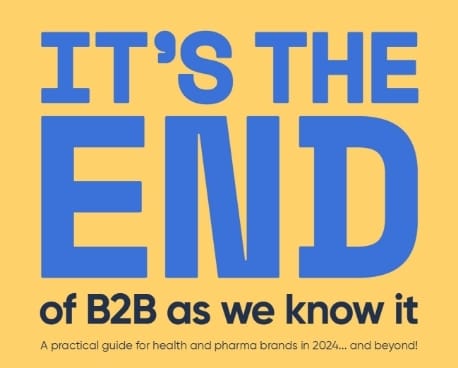In the world of digital marketing, aspirational value propositions have long been celebrated as a powerful tool for attracting and engaging audiences.
By presenting a sense of optimism and possibility, and showing the ‘future state’ of those using a product or service, marketers aim to create a vision of a better future, encouraging consumers to aspire to that future and, consequently, adopt that treatment, product or device.
However, in the complex and sensitive world of healthcare, an aspirational value proposition can often pose challenges, making campaigns less relatable and, ultimately, less effective.
In this article, Medico Digital’s Lizz Summers – a lead strategist for some of the biggest brands within the healthcare industry in recent years – explores the challenges of aspirational messaging in the context of patient care, suggesting some top tips on finding the right balance.

What is a value proposition?
In simple terms, a value proposition is a concise statement that outlines why a consumer (in this case, a patient or HCP) should choose your product or service.
Typically focused on the benefits that the product or service can bring, it is often supported by evidenced claims and will outline how it offers a solution to the specific pain points or challenges experienced by an intended user.
The aspirational trap: alienating real-world patients
An aspirational value proposition often hinges on creating an appealing and positive view of the future.
A company will identify how it wants its audience to feel – whether that’s having more energy, being able to do things they couldn’t before or having a sense of peace or freedom from not needing to worry about their health condition.
Those campaigns you see with well-dressed, happy-looking people looking wistfully out to sea (‘representing freedom and possibility’), for example, or featuring images of people playing sports and taking on epic outdoorsy challenges (now that they are ‘free from the worries of monitoring their blood sugar’) – those are all examples of aspirational value propositions turned into creative concepts.
While the reasoning behind these creative concepts may be well-intentioned, they will often struggle to deliver a key component of any good marketing campaign: relatability.
The importance of relatability

Relatability can offer a huge number of benefits within the world of marketing – as has been shown through various studies. For example, relatability has been found to:
1. Deliver an emotional connection: Relatable content helps establish an emotional connection between the brand and the audience, leading to higher levels of engagement and trust (Lin, 2021).
2. Enhance perceived authenticity: Relatable content is often perceived as more authentic, which can then boost a brand’s credibility and authenticity (Smith & Fischer, 2018).
3. Improve message receptivity: Relatable content captures the audience’s attention and keeps them more receptive to the marketing message, making it more effective (Escalas & Stern, 2003).
4. Encourage customer loyalty: Customers who find content relatable are more likely to become loyal to the brand and make repeat purchases (Chaudhuri & Holbrook, 2001).
5. Create a social community: Relatable content can help create a sense of belonging and community among customers (Bateman, 2021)
6. Improve personalisation and relevance: Tailoring content to the preferences and experiences of the audience enhances relevance, making customers feel seen and understood (Li et al., 2019).
Ultimately, relatability is one of – if not – the most important aspect of a successful healthcare marketing campaign. Without making your content relatable to your target audience, it could fail before it’s even had a chance to get going.
Keeping patients front and centre

One of the primary goals of healthcare marketing is to resonate with real-world patients and healthcare professionals (HCPs).
Aspirational value propositions often miss the mark in this regard, creating a perception that the campaign is out of touch with the realities of patients’ lives and HCPs’ day-to-day experiences.
Imagine a marketing campaign for a chronic respiratory condition like COPD, for example, where well-presented ‘patients’ are shown to be entertaining friends for dinner in a clean, spacious home.
On the face of it, this may seem like a simple aspirational image, designed to give patients and HCPs a flavour of what things they can enjoy if their condition is more well-controlled.
In reality, however, COPD disproportionately affects people from lower socio-economic groups (Grigsby et al., 2016), with many people with the condition struggling to perform even basic daily activities (WHO, 2023), like washing, dressing and preparing food for themselves.
As such, the proposed campaign – albeit well-intentioned – could alienate the majority of real patients who don’t fit into this mould. This can then leave them feeling overlooked or misunderstood, and make it seem like the brand is out of touch with the real challenges that living with COPD can involve.
As a result of this, patients may also become skeptical of the claims that a product or service is making, especially if they have tried other products and services in the past that have not worked.
Therefore, healthcare and pharma companies need to be mindful of the realities of living with health conditions and create a deep understanding and genuine, informed empathy for the individuals their product or service is designed for.
Resonate, don’t differentiate
The same can also be true of healthcare professionals. Often, marketing campaigns depict HCPs in high-spec labs and custom-built hospital complexes, working with state-of-the-art equipment and having calm, collaborative consultations with their patients.
In contrast, the realities of working as a HCP are often very different.
When Lizz worked as a HCP herself, for example, she remembers sellotaping her desk back together every morning, having seven minutes per patient consultation on average and putting money in a jar each month to ensure tea and coffee were available at work.
The realities of these frustrations and feelings of burnout have not gone away since then either. In fact, they have only gotten worse since the Covid-19 pandemic (Kapil et al. 2022).
While value propositions and offerings from pharma and healthcare companies to HCPs can be appealing, such as educational days, lunch and learns, or accessing cutting-edge technologies, it’s also important to recognise the realities and limitations of those working in the space.
Consider, for example: how will they pay for the train fare to get to your CPD day? Will your innovations work with their decades-old clinic equipment? And is the product or service you’re offering actually realistic, affordable and relevant to them?
Ultimately, healthcare and pharma brands need to show that they understand ‘real life’ and are part of the same team, rather than appearing out of touch about the real world of delivering healthcare.
How to adopt a more balanced approach
Aspirational value propositions have their place in healthcare marketing, but it’s crucial to adopt a more balanced approach. With this in mind, here are some tips for crafting effective, relatable and ethical healthcare marketing campaigns:
1. Get to know your audience, beyond demographics
Healthcare and pharma brands need to understand the profile of their patient groups.
While many patient segmentation programs are built on demographics like age and gender, it’s important to go beyond these and understand the wider profile of your patient group, by looking at factors like socioeconomic status, education, health literacy and other Social Determinants of Health.
Tools including ethnographic research, interviews, focus groups and social listening can also help uncover key insights and challenges that brands would otherwise be unaware of.
2. Avoid stereotypes
Too often, older people become pigeon-holed into particular hobbies and interests; golf, jigsaw puzzles, knitting…
In reality, people’s interests are often more nuanced and culturally influenced. Therefore, it’s important to ensure that campaigns are not reinforcing unhelpful stereotypes or dated narratives. One way to do this effectively is to…
3. Involve patients and HCPs in your marketing activity (and not just PAGs!)
Often, marketing campaigns are created in an ‘ivory tower’ and will either not be tested with real patients or HCPs, or will only be tested in the latter stages of development when there is a straight choice of message A vs. message B.
Instead, the questions you should be asking are: do any of these messages resonate with you? And, if not, why?
Additionally, when brands do involve patients and HCPs, these will often be representatives from Patient Advisory Groups (PAGs) or Key Opinion Leaders (KOLs).
While gathering inputs from these groups can be incredibly useful, these groups or individuals are typically the most active, engaged, ambitious or well-connected and, in most cases, will not offer a true representation of patients or ‘jobbing’ HCPs. Therefore, try to involve a realistic representative group of patients and HCPs when exploring your marketing and messaging (remember, you may need to make adjustments to make it possible for these individuals to take part).
4. Be transparent
Transparency and authenticity are becoming increasingly important in marketing, as reflected by new guidance that specifies the need to use the ‘#Ad’ hashtag when using influencer marketing to post on social channels.
Healthcare brands can help increase trust, authenticity and transparency in the same way by being open about whether they are using actors or real patients and HCPs in their marketing efforts.
Many brands are increasingly choosing real patients over actors in this regard; an initiative designed to not only boost relatability but also create meaningful partnerships between patients and organisations.
(Side note: a patient photo shoot is one of the best ways to see the realities of life as a patient!)
5. Balance aspiration with relatability
While it’s reasonable for your value proposition to be aspirational, consider how you can add elements of relatability into your creative concepts, messaging and campaigns.
While you might not want to go as far as IKEA’s recent ‘Life is not an IKEA catalogue’ campaign, there are many ways to connect with your audience through simple changes.
From recognising that, for many patients, being able to carry in their shopping from the car is as aspirational as hiking up a mountain, or that the small moments of connection – a cup of tea with a neighbour – are much more relatable than hosting a dinner party for ten.
Moving towards a more relatable future
People tend to prefer more relatable content in marketing because it fosters emotional connections, enhances authenticity, boosts message receptivity and enhances brand trust.
While aspirational value propositions have their place in healthcare and pharma marketing, brands should be mindful to ensure that their campaigns are rooted in relatability and relevance.
If you need help with your strategic digital marketing, our team are always on hand to help. Simply contact us to find out more about the services we offer and how we can create relatable marketing campaigns for your healthcare or pharma brand.
References:
Lin, X. (2021). The Impact of Brand Relatability on Consumer Responses to Social Media Advertising. Journal of Advertising. 50(3), 249-264.
Smith, A. N., & Fischer, E. (2018). How Companies Can Take a Stand Without Tanking Their Sales. Harvard Business Review.
Escalas, J. E., & Stern, B. B. (2003). Sympathy and Empathy: Emotional Responses to Advertising Dramas. Journal of Consumer Research, 29(4), 566-578.
Chaudhuri, A., & Holbrook, M. B. (2001). The Chain of Effects from Brand Trust and Brand Affect to Brand Performance: The Role of Brand Loyalty. Journal of Marketing, 65(2), 81-93.
Muniz, A. M., & O’Guinn, T. C. (2001). Brand Community. Journal of Consumer Research, 27(4), 412-432.
Bateman, A. (2021) Why Belonging Is The New Customer Loyalty And Three Ways To Cultivate It. Forbes, https://www.forbes.com/sites/forbesbusinesscouncil/2021/05/12/why-belonging-is-the-new-customer-loyalty-and-three-ways-to-cultivate-it/?sh=7b5c76281185
Li, X., Huang, L., & Luo, X. (2019). Personalized Advertising Effectiveness: The Role of Ad Content and Form. Journal of Marketing, 83(1), 31-48.
Grigsby M, Siddharthan T, Chowdhury MA, Siddiquee A, Rubinstein A, Sobrino E, Miranda JJ, Bernabe-Ortiz A, Alam D, Checkley W. (2016) Socioeconomic status and COPD among low- and middle-income countries. Int J Chron Obstruct Pulmon Dis.;11:2497-2507. doi: 10.2147/COPD.S111145. PMID: 27785006; PMCID: PMC5065097.
World Health Organization, 2023 https://www.who.int/news-room/fact-sheets/detail/chronic-obstructive-pulmonary-disease-(copd)
Kapil V, Collett G, Godec T, Gupta J, Maniero C, Ng SM, McIntosh I, Kumar A, Nair S, Kotecha A, Janmohamed A, Antoniou S, Khan R, Khanji MY, Siddiqui I, Gupta A. Longitudinal comparisons of mental health, burnout and well-being in patient-facing, non-patient-facing healthcare professionals and non-healthcare professionals during the COVID-19 pandemic: findings from the CoPE-HCP study. BJPsych Open. 2022 Sep 27;8(5):e173. doi: 10.1192/bjo.2022.579. PMID: 36164721; PMCID: PMC9530379.
WHO, 2023, Social Determinants of Health, https://www.who.int/health-topics/social-determinants-of-health#tab=tab_1






